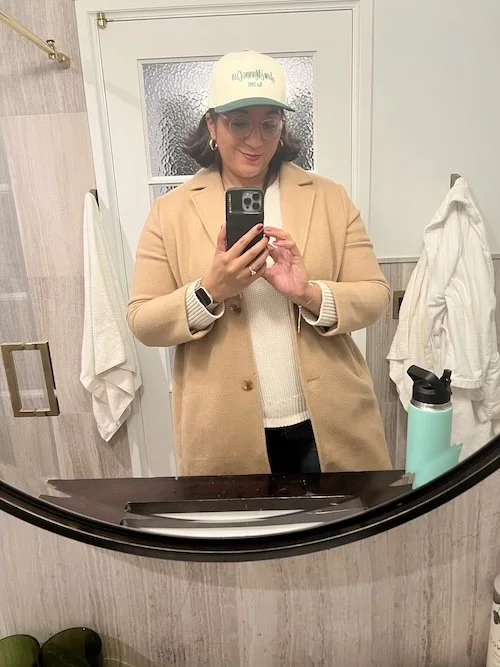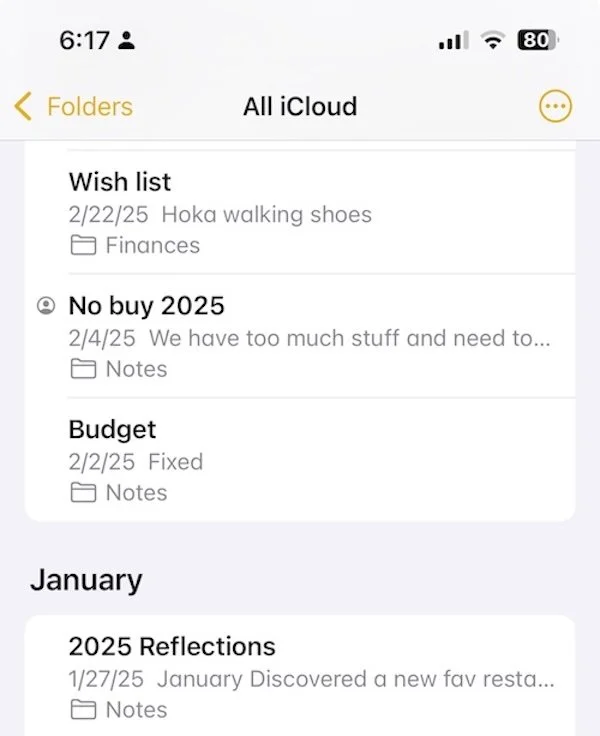How to Have a No-Buy Year – Tips I’ve Learned So Far
A no-buy year is all the rage on social media this year ( it's got a hashtag on TikTok, a documentary on Netflix, and has even been featured in The New York Times), and for good reason!
It's a powerful way to reset your spending habits and become more mindful about non-essential spending. I used to think challenges like these were so restrictive and not fun, and while they are challenging, they really aren't about deprivation.
Instead, a no-buy year is about understanding what truly adds value to your life and eliminating what doesn't. It's also super helpful for breaking the cycle of impulsive shopping and unnecessary shopping. I've done no-buy and underconsumption challenges a few times (which I wrote about in Less Is More: Embracing the Art of Underconsumption), and I have to admit that I like how I feel when I do them, so now they are becoming an essential part of my self-care routine.
What motivated me to take on this challenge was a simple decluttering project where I swapped out my bathroom storage furniture. When I did that, I saw how many unused items were hiding in my bathroom and how many new items had entered the chat, so to speak. It was alarming for me to see so much stuff, so I decided this year it was time for a change.
If you’ve been exploring underconsumption, a no-buy year could be your next step toward a more intentional lifestyle. To set you up for success, I've pulled together everything I've learned so far so you can prepare and crush your no-buy year like a pro.
Step 1: Define Your Why (It’ll Keep You Motivated!)
Before starting, clarify why you’re doing this. Is it to pay off student loans, save for a big goal, or reassess your relationship with consumption? Your “why” will help you resist temptation when new items catch your eye.
Many challenge participants ( myself included) find that writing down their motivation in the notes app on their phones helps them stay committed.
It's an easy reference guide that you can add to your home screen to remind yourself of what you're aiming to achieve. For example, my why is to own less stuff and use what I have.
Step 2: Set Clear Rules (What’s Allowed & What’s Not)
In addition to noting your why, you'll want to spell out your rules for this challenge. I recommend listing out what you're not allowed to buy and what is okay to spend on. A no-spend challenge doesn’t mean you can’t buy anything—you just need specific rules that fit your life.
After all, you are human, and life does happen, so you'll need to make a plan for yourself when things pop up. The three areas I would spell out are:
Non-essential items to avoid: new clothes, beauty products, home decor, fast food, candles, video games, fast fashion, and online shopping.
Essentials that are allowed: toilet paper, pantry staples, basic needs, or workout classes.
Gray areas to consider: Are secondhand purchases (thrift store finds), gifts from others, or small business purchases allowed?
Gifts & occasions: Are you allowed to treat yourself for your birthday or a promotion? Or are you only spending on others?
Be realistic and kind to yourself when taking on a challenge like this: A low-buy year might be a better fit than a full year of no spending if you're new to this.
This is your life, and you can go at any pace that feels right to you, and you can make adjustments as needed.
Step 3: Track Your Progress & Shopping Habits
Use your notes app to track what you’re not buying and how you feel about it. I'd also write about how much you're saving over time.
Reflect on the end of the month: Were there weak moments? What triggered them? (Pop-up promotions? Stress?) Seeing your progress in writing can be really motivating. Also, tracking these things will remind you that you can do hard things, commit to change, and keep your promises. It's almost like having an accountability partner in the palm of your hand.
By writing these things down, you can also identify patterns and deep issues that may be worth addressing. For example, I noticed that I love to treat myself to things daily, which is excessive. Especially when the treat always has dollar signs attached to it. Redefining what I deem a treat has been the most fun part of this challenge. I am realizing how many free things bring me joy.
Another way I've been tracking my progress is by keeping a bag full of my empties; these are all the things I've used up to completion. Visually seeing this reminds me that I have plenty and can use what I have. I've taken pictures of everything at the end of the month so I have a record of it.
Step 4: Replace Shopping With New Activities
If spending money is a hobby for you, it’s important to fill that space with new ways to spend time.
If you struggle with impulse purchases, avoid visiting shopping malls for a set period of time, unsubscribe from store emails, and remove saved credit card info from shopping sites as well.
You need to give yourself time to turn off that part of your brain. Instead of shopping, spend some time creating a bucket list of activities so you spend less time shopping. This could include things like exploring local parks, starting a creative project, or hosting a quality time night with friends.
Keep a wish list of things you’d love to buy later. This helps you curb impulse purchases and decide if you truly want this item or if it was just an impulse. Creating a wishlist also gives loved ones gift ideas (great way to avoid unwanted gifts!).
Step 5: Accept That Slip-Ups Will Happen (And Keep Going!)
No one is perfect. If you buy something unplanned, don’t quit—learn from it and move forward.
At the end of the day, the goal isn’t perfection—it’s mindfulness and progress. In my notes app, I included a list of incentives or rewards to help me not slip up, and if I do slip up, then I don't get that reward for the month. Again, you know yourself best, so do what works for you, but no matter what, don't give up!
I recommend planning how you’ll reward yourself at the end of the year—whether it’s allowing a planned purchase or simply reflecting on how much money you saved. Spelling this out will motivate you and remind you why you're doing this (paying down credit card debt, finding different hobbies, or saving the planet).
Whatever the reason, it's important to keep it at the forefront and tell yourself that what you're embarking on is worthwhile and beneficial, so it's worth seeing it through.
Could You Try a No-Buy Year?
Well, that sums up everything I've learned so far! It's only been two months, so I'm sure more nuggets of knowledge are bound to pop up. Stay tuned as I continue to share my experience.
My final parting advice for you is this: if a full year sounds daunting, start with a low-spend month or no-buy month to test it out. This is how I dipped my toe in, and I'm so glad I did.
Share your thoughts in the comments—have you tried a low-buy challenge? What are your favorite ways to be more intentional with your spending and consumption?



